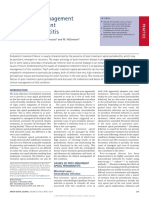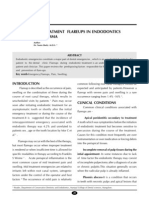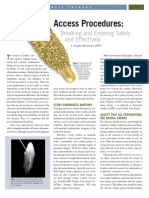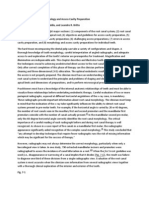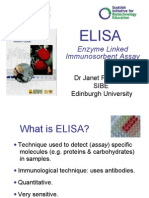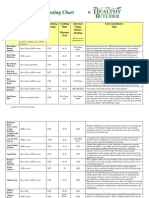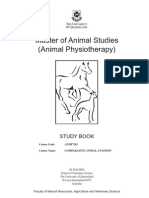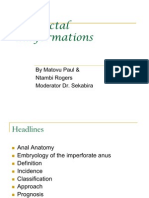0 ratings0% found this document useful (0 votes)
146 viewsEndodontic Microbiology: Dr. Ammar Abu Mostafa
Endodontic Microbiology: Dr. Ammar Abu Mostafa
Uploaded by
pattasonThis document discusses endodontic microbiology and the treatment of endodontic infections. It covers the portals of entry for bacteria to enter the pulp, the role of bacteria in pulp necrosis and periapical disease, and some of the common bacterial species found in endodontic infections like Enterococcus faecalis. It also discusses abscesses, cellulitis, and the treatment of endodontic infections which involves debridement, irrigation with sodium hypochlorite and EDTA, intracanal medication with calcium hydroxide, and drainage.
Copyright:
© All Rights Reserved
Available Formats
Download as PPT, PDF, TXT or read online from Scribd
Endodontic Microbiology: Dr. Ammar Abu Mostafa
Endodontic Microbiology: Dr. Ammar Abu Mostafa
Uploaded by
pattason0 ratings0% found this document useful (0 votes)
146 views12 pagesThis document discusses endodontic microbiology and the treatment of endodontic infections. It covers the portals of entry for bacteria to enter the pulp, the role of bacteria in pulp necrosis and periapical disease, and some of the common bacterial species found in endodontic infections like Enterococcus faecalis. It also discusses abscesses, cellulitis, and the treatment of endodontic infections which involves debridement, irrigation with sodium hypochlorite and EDTA, intracanal medication with calcium hydroxide, and drainage.
Original Description:
Microbes associated with endodontic infections
Original Title
Endodontic microbiology
Copyright
© © All Rights Reserved
Available Formats
PPT, PDF, TXT or read online from Scribd
Share this document
Did you find this document useful?
Is this content inappropriate?
This document discusses endodontic microbiology and the treatment of endodontic infections. It covers the portals of entry for bacteria to enter the pulp, the role of bacteria in pulp necrosis and periapical disease, and some of the common bacterial species found in endodontic infections like Enterococcus faecalis. It also discusses abscesses, cellulitis, and the treatment of endodontic infections which involves debridement, irrigation with sodium hypochlorite and EDTA, intracanal medication with calcium hydroxide, and drainage.
Copyright:
© All Rights Reserved
Available Formats
Download as PPT, PDF, TXT or read online from Scribd
Download as ppt, pdf, or txt
0 ratings0% found this document useful (0 votes)
146 views12 pagesEndodontic Microbiology: Dr. Ammar Abu Mostafa
Endodontic Microbiology: Dr. Ammar Abu Mostafa
Uploaded by
pattasonThis document discusses endodontic microbiology and the treatment of endodontic infections. It covers the portals of entry for bacteria to enter the pulp, the role of bacteria in pulp necrosis and periapical disease, and some of the common bacterial species found in endodontic infections like Enterococcus faecalis. It also discusses abscesses, cellulitis, and the treatment of endodontic infections which involves debridement, irrigation with sodium hypochlorite and EDTA, intracanal medication with calcium hydroxide, and drainage.
Copyright:
© All Rights Reserved
Available Formats
Download as PPT, PDF, TXT or read online from Scribd
Download as ppt, pdf, or txt
You are on page 1of 12
ENDODONTIC
MICROBIOLOGY
ENDO 412 Lecture No 5 part II
Dr. Ammar Abu Mostafa
Learning outcomes
Portals of entry to the pulp
Bacterial role in Pulp and Peri-apical pathosis
Enterococcus faecalis
Absecess and Cellulitis
Management of the infected teeth
Portals of Entry to the Pulp
Caries
Through anomalous tract like radicular lingual groove
Through fracture line
Via exposed dentin
Around restorations
From periodontal pockets to the pulp via apical
foramen, accessory and lateral canals
Pulp Necrosis & Bacterial Invasion
Bacterial penetration into dentinal tubules of
necrotic teeth is greater than teeth with vital pulp,
due to the following reasons:
1. The presence of fluids in dentinal tubules
2. The presence of odontoblastic processes
3. Formation of tertiary dentin
Vital pulp is more resistant to bacterial invasion than
necrotic pulp
Bacterial Role in Pulp Infection
In an experimental study; after intentional pulp
exposure, pulp necrosis and periradicular lesion
developed in rats with normal microbial flora but not
in germ-free rats
Microorganisms invade the necrotic pulp and infect
the root canal system, including the dentinal tubules
Coccal forms of bacteria seen in the
cross-section of a fractured dentinal tubule
Most of the bacteria in an endodontic infection are
strict anaerobes
With increasing time and depth of pulp infection, the
microbial flora changes from a predominantly
facultative, Gram-positive flora to an almost
completely anaerobic and mainly Gram-negative flora.
Endodontic infections are polymicrobial, no single
microorganism or group of bacteria has been proven
to be more pathogenic than another.
The following strains are commonly found in
endodontic infections: Fusobacterium , Prevotella,
Prophyromonas, Peptostreptococcus, and Veillonella.
The microbial flora in retreatment cases is different
from bacteria in primary apical periodontitis. Typically
retreatment cases show enterococcus faecalis ,
streptococci, and anaerobic Gram-positive rods in high
frequencies.
Fungi have been identified in root canals and in teeth
refractory to RCT.
Viruses, including HIV, are also present in the pulp.
Bacterial Role in Periradicular Disease
Bacteria and bacterial by-products of the root canal
play the major role of periradicular lesion
The bacteria are polymicrobial and are similar to
those isolated from infected root canals
Resistance of Oral Microbes to
Medicaments
Enterococci has been shown to be relatively
resistant to Ca(OH)2 and occur in high frequency in
retreatment cases
Abscess & Cellulitis
Abscess is a cavity containing pus (purulent
exudate) consisting of bacteria, bacterial by-products,
inflammatory cells, numerous lysed cells, and the
contents of those cells.
Cellulitis is a diffuse, erythematous, mucosal, or
cutaneous infection that may rapidly spread into
deep facial spaces and become life threatening.
Treatment of Endodontic Infections
The key to successful treatment of endodontic
infections is removal of the reservoir of infection
(necrotic tissue, bacteria, and bacterial by-products) by
the following procedures:
1. Debridement of the root canal system by mechanical
instrumentation
2. Root canal irrigation: NaOCl & EDTA
3. Intracanal medication: Ca(OH)2
4. Drainage
End of the Lecture
You might also like
- Standard Abbreviations For Veterinary Medical Records, 3rd EditionDocument35 pagesStandard Abbreviations For Veterinary Medical Records, 3rd EditionFabricamargo100% (1)
- Final PDLDocument100 pagesFinal PDLDrRahat SaleemNo ratings yet
- Oral Wound Healing: Cell Biology and Clinical ManagementFrom EverandOral Wound Healing: Cell Biology and Clinical ManagementHannu LarjavaNo ratings yet
- Occlusal SplintDocument26 pagesOcclusal SplintNena TamaraNo ratings yet
- Acute Gastroenteritis With Moderate DehydrationDocument28 pagesAcute Gastroenteritis With Moderate DehydrationSan Dee75% (8)
- Microbiology of EndodonticsDocument38 pagesMicrobiology of EndodonticsAndi Ika Purnama PutriNo ratings yet
- Microbiology Aspect in EndodonticsDocument80 pagesMicrobiology Aspect in Endodonticswhussien7376100% (1)
- Endodontic MicrobiologyDocument9 pagesEndodontic MicrobiologySarah KahilNo ratings yet
- Handbook for Microbiology Practice in Oral and Maxillofacial Diagnosis: A Study Guide to Laboratory Techniques in Oral MicrobiologyFrom EverandHandbook for Microbiology Practice in Oral and Maxillofacial Diagnosis: A Study Guide to Laboratory Techniques in Oral MicrobiologyNo ratings yet
- Periodontal Pocket PathogenesisDocument23 pagesPeriodontal Pocket Pathogenesisperiodontics07No ratings yet
- Pathological Tooth ResorptionDocument143 pagesPathological Tooth ResorptionAnas KallayilNo ratings yet
- Apical Third and Its SignificanceDocument20 pagesApical Third and Its SignificanceBharath Ratnakaram100% (1)
- Endo Access Cavity Preparation 5Document176 pagesEndo Access Cavity Preparation 5ahead1234No ratings yet
- PulpDocument54 pagesPulpAnsh DuttaNo ratings yet
- Dental HipersensitivityDocument28 pagesDental HipersensitivitySergio KancyperNo ratings yet
- Biofilm in Endodontics Current Status and Future DirectionDocument60 pagesBiofilm in Endodontics Current Status and Future DirectionKassim OboghenaNo ratings yet
- Kutler's Thery PDFDocument10 pagesKutler's Thery PDFSam RoyNo ratings yet
- Focal Infection Theory: A Focus On Current AspectsDocument7 pagesFocal Infection Theory: A Focus On Current AspectsDiandra Puspa WidyasariNo ratings yet
- DetectionDocument8 pagesDetectionJanani GopalakrishnanNo ratings yet
- Perforation RepairDocument11 pagesPerforation RepairRuchi ShahNo ratings yet
- Apexification With MTADocument9 pagesApexification With MTAIngrid PatriciaNo ratings yet
- Influence of Size and Taper of Basic Root Canal Preparation On Root Canal Cleanliness A Scanning Electron Microscopy Study.Document9 pagesInfluence of Size and Taper of Basic Root Canal Preparation On Root Canal Cleanliness A Scanning Electron Microscopy Study.Lina SaadNo ratings yet
- Nano DentistryDocument104 pagesNano DentistryShameena KnNo ratings yet
- Enamel Remineralization A Novel Approach To Treat Incipient CariesDocument5 pagesEnamel Remineralization A Novel Approach To Treat Incipient CariesInternational Journal of Innovative Science and Research TechnologyNo ratings yet
- Lasers Used in Operative Dentistry and EndodonticsDocument28 pagesLasers Used in Operative Dentistry and EndodonticsNingombam Robinson Singh50% (2)
- 6 Surgical Periodontal TherapyDocument38 pages6 Surgical Periodontal TherapyPriya SargunanNo ratings yet
- Irrigation and Intracanal Medicaments - Lecture 2 - LDocument49 pagesIrrigation and Intracanal Medicaments - Lecture 2 - Lshobhana20100% (1)
- A Cess Cavity PreparationDocument54 pagesA Cess Cavity Preparationmandy0077No ratings yet
- Diagnosis & Case Selection in EndodonticsDocument54 pagesDiagnosis & Case Selection in EndodonticsRawzh Salih MuhammadNo ratings yet
- Smearlayerinendodontics 170106182934Document80 pagesSmearlayerinendodontics 170106182934GetLyricsNo ratings yet
- Apical Seal Versus Coronal SealDocument8 pagesApical Seal Versus Coronal SealSalem RawashdahNo ratings yet
- Antibiotics in Endodontics-Lecture 9Document49 pagesAntibiotics in Endodontics-Lecture 9mirfanulhaqNo ratings yet
- Anatomy of The Pulp SpaceDocument35 pagesAnatomy of The Pulp SpaceDeen MohdNo ratings yet
- Recent Advances in Irrigation Systems PDFDocument6 pagesRecent Advances in Irrigation Systems PDFdrvivek reddyNo ratings yet
- DentinDocument89 pagesDentinDr Zadeno kithanNo ratings yet
- Week 7 Histology Physiology of Dental Pulp MiriamDocument4 pagesWeek 7 Histology Physiology of Dental Pulp MiriamDelaney IslipNo ratings yet
- Causes and Management of Post-Treatment Apical PeriodontitisDocument8 pagesCauses and Management of Post-Treatment Apical PeriodontitischristianNo ratings yet
- Periodontium 1Document65 pagesPeriodontium 1Hussain M A KhuwajaNo ratings yet
- Surgical Vs Non-Surgical Approach in PeriodonticsDocument13 pagesSurgical Vs Non-Surgical Approach in PeriodonticsBea Dominguez100% (1)
- Dental Caries: by DR: Hanan Eid GamalDocument107 pagesDental Caries: by DR: Hanan Eid Gamalruchika100% (1)
- Diagnostic Instruments in PerioDocument82 pagesDiagnostic Instruments in PerioSunny Mavi100% (1)
- Mid Treatment FalreupsDocument4 pagesMid Treatment FalreupsAhmed AzizaNo ratings yet
- Intracanal MedicamentsDocument155 pagesIntracanal Medicamentssrishti jaiswalNo ratings yet
- Regen EndoDocument88 pagesRegen EndoJitender ReddyNo ratings yet
- Management of Discoloured ToothDocument8 pagesManagement of Discoloured ToothAnurtha AnuNo ratings yet
- Assessment of Coronal Microleakage of Different Temporary RestorativeDocument4 pagesAssessment of Coronal Microleakage of Different Temporary RestorativeIzumi Jugha JavieraNo ratings yet
- Slide - 11 - Procedural AccidentsDocument31 pagesSlide - 11 - Procedural AccidentsCWT2010100% (1)
- Access ProceduresDocument4 pagesAccess ProceduresMonica Ioana Teodorescu100% (1)
- DIAGNOSTIC METHODS (Emphasis On Recent Advances) IN EndodonticsDocument51 pagesDIAGNOSTIC METHODS (Emphasis On Recent Advances) IN EndodonticsKalpesh Dey100% (1)
- Risk Management in EndodonticsDocument39 pagesRisk Management in EndodonticsDrSree KanthNo ratings yet
- !!! Root Canal Morphology and It's Relationship To Endodontic Procedures - Frank J. Vertucci !!!Document27 pages!!! Root Canal Morphology and It's Relationship To Endodontic Procedures - Frank J. Vertucci !!!Puscas Madalina100% (1)
- Chapter 7 Tooth Morphology and Access Cavity PreparationDocument232 pagesChapter 7 Tooth Morphology and Access Cavity Preparationusmanhameed8467% (3)
- Imaging in Periodontics PerioDocument49 pagesImaging in Periodontics PerioFourthMolar.comNo ratings yet
- Treatment of Dental Caries in The Young PermanentDocument39 pagesTreatment of Dental Caries in The Young PermanentShahid HameedNo ratings yet
- Local Anaesthesia in Dentistry A ReviewDocument9 pagesLocal Anaesthesia in Dentistry A ReviewAshyana SaeedNo ratings yet
- Endo Perio RelationsDocument28 pagesEndo Perio RelationsMunish Batra100% (1)
- Intra Canal MedicamentsDocument14 pagesIntra Canal MedicamentsS Noshin ShimiNo ratings yet
- 10 1016@j Joen 2020 01 023Document23 pages10 1016@j Joen 2020 01 023Jorge OrbeNo ratings yet
- Surgical Complications in Oral Implantology: Etiology, Prevention, and ManagementFrom EverandSurgical Complications in Oral Implantology: Etiology, Prevention, and ManagementNo ratings yet
- Minimally Invasive Periodontal Therapy: Clinical Techniques and Visualization TechnologyFrom EverandMinimally Invasive Periodontal Therapy: Clinical Techniques and Visualization TechnologyNo ratings yet
- Basic Level of Dental Resins - Material Science & Technology: 4th Edition, 2nd VersionFrom EverandBasic Level of Dental Resins - Material Science & Technology: 4th Edition, 2nd VersionNo ratings yet
- Burstone's Biomechanical Foundation of Clinical Orthodontics: Second EditionFrom EverandBurstone's Biomechanical Foundation of Clinical Orthodontics: Second EditionNo ratings yet
- 3 1 1 Exchange Surfaces Workbook NotesDocument19 pages3 1 1 Exchange Surfaces Workbook Notes17wrightiNo ratings yet
- Male Circumcision Removes 16+ Functions. Do You Know What They Are?Document9 pagesMale Circumcision Removes 16+ Functions. Do You Know What They Are?Piet JassogneNo ratings yet
- PT3 ELSA SampleDocument8 pagesPT3 ELSA Samplefattahjamal50% (2)
- Renal Vascular DiseasesDocument56 pagesRenal Vascular Diseasesjohny3333No ratings yet
- NBME 11 Withc AnswersDocument203 pagesNBME 11 Withc AnswersDany Paul BabyNo ratings yet
- Feldenkrais Unstable EquilibriumDocument15 pagesFeldenkrais Unstable Equilibriumvk100% (2)
- ElisaDocument29 pagesElisaapi-19983976No ratings yet
- Poultry Body Systems and FunctionsDocument12 pagesPoultry Body Systems and FunctionsNilesh RajNo ratings yet
- Growth FantasticDocument120 pagesGrowth FantasticBrandon TeapasNo ratings yet
- TheHealthyButchers UltimateRoastingChartDocument3 pagesTheHealthyButchers UltimateRoastingChartfiretamer24No ratings yet
- Main Sensory OrgansDocument33 pagesMain Sensory OrgansKKhowardNo ratings yet
- Cementum PDFDocument72 pagesCementum PDFOjasviNo ratings yet
- Comparative Animal AnatomyDocument324 pagesComparative Animal AnatomyMohammed Anuz83% (6)
- DMLTDocument24 pagesDMLTavrajamohamedNo ratings yet
- Anorectal Malformation - Ayat5Document48 pagesAnorectal Malformation - Ayat5Christ PhanerooNo ratings yet
- Lear Spreads Wings After China Training: Elphos EraldDocument6 pagesLear Spreads Wings After China Training: Elphos EraldThe Delphos HeraldNo ratings yet
- Sessions 8 To 10 Key AnswersDocument6 pagesSessions 8 To 10 Key AnswersJJ AngNo ratings yet
- Biology Scheme Form 2Document17 pagesBiology Scheme Form 2adrianoscarray445No ratings yet
- Agri - Dragonfruit (Hylocereus Undatus) Stem Meal Supplementation in BroilersDocument71 pagesAgri - Dragonfruit (Hylocereus Undatus) Stem Meal Supplementation in Broilersjvb_buena273467% (3)
- A Dark Brown DogDocument8 pagesA Dark Brown DogVelmurugan SubramaniamNo ratings yet
- COVID Undertaking PDFDocument2 pagesCOVID Undertaking PDFAnmol SinghNo ratings yet
- Method of IstinjaDocument24 pagesMethod of IstinjaIslamic Library100% (1)
- 9 Ways To Fight CancerDocument103 pages9 Ways To Fight Cancervisualizeyoursuccess3851100% (3)
- Chapter 36-1 Reproductive SystemsDocument25 pagesChapter 36-1 Reproductive Systemsnancie8No ratings yet
- Dogs & Wolves Have A Shorter Genetic Distance Between Each Other Than Negroids & Non-Negroids.Document7 pagesDogs & Wolves Have A Shorter Genetic Distance Between Each Other Than Negroids & Non-Negroids.Race-Realist67% (3)
- Worksheet - Evolution PacketDocument10 pagesWorksheet - Evolution PacketjtNo ratings yet
- Kemoterapi Lepra: Bag. Farmakologi Dan Terapi FK Undip 2017Document24 pagesKemoterapi Lepra: Bag. Farmakologi Dan Terapi FK Undip 2017Yeni HerawatiNo ratings yet




































